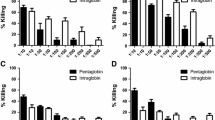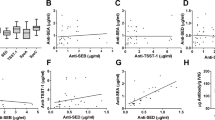Summary
An enzyme-linked immunosorbent assay (ELISA) was used with purified α-toxin and teichoic acid preparations to measure the IgG and IgM response inStaphylococcus aureus infections. After determining antibodies in a normal population, cut-off levels were set for all age groups. ELISA with α-toxin was more sensitive than the antistaphylolysin neutralization test (ASTA). Determining IgM antibodies with the two antigens was found to be of limited diagnostic value. Positive IgG titers against α-toxin were found in 21 of 27 patients (78%) with endocarditis, 11 of 14 (79%) with complicated septicemia, eight of 20 (40%) with uncomplicated septicemia and in 12 of 22 (54%) with chronic osteomyelitis. The IgG responses to teichoic acid and α-toxin were somewhat different when measured by ELISA, and the parallel performance of the two assays resulted in improved serological diagnostics. The number of positive patients increased to 89%, 86%, 65% and 64%, respectively, in the four groups with a diagnostic specificity of 93%. In septicemic staphylococcal infections, the diagnosis could be established in all patients (28 of 28) with adequately spaced paired samples.
Zusammenfassung
Zur Bestimmung der IgG-und IgM-Antwort bei Infektionen durchStaphylococcus aureus wurde ein Enzym-gebundener Immunsorbent-Test (ELISA) mit gereinigtem α-Toxin und Teichonsäure eingesetzt. Nach Bestimmung der Antikörper bei Normalpersonen wurden für alle Altersgruppen Grenzwerte festgelegt. ELISA mit α-Toxin war empfindlicher als der Antistaphylolysin-Neutralisationstest (ASTA). Die Bestimmung der IgM-Antikörper mit den beiden Antigenen war nur von beschränktem diagnostischen Wert. Die Titerbestimmung von IgG gegen α-Toxin war bei 21 von 27 Patienten mit Endokarditis (78%). 11 von 14 Patienten mit komplizierter Septikämie (79%), acht von 20 Patienten mit unkomplizierter Septikämie (40%) und bei 12 von 22 Patienten mit chronischer Osteomyelitis (54%) positiv. Die mit ELISA bestimmte IgG-Antwort auf Teichonsäure und α-Toxin wich von diesen Werten etwas ab; bei parallelem Einsatz beider Assays ließ sich die serologische Diagnostik verbessern. Der Prozentsatz positiver Fälle erhöhte sich in den vier Gruppen auf 89%, 86%, 65% und 64% bei einer diagnostischen Spezifität von 93%. Staphylokokkeninfektionen mit septischem Verlauf konnten bei Abnahme gepaarter Proben in angemessenem Abstand bei allen Patienten (28 von 28) diagnostiziert werden.
Similar content being viewed by others
Literatur
Sperber, W. H. The identification of staphylococci in clinical and food microbiology laboratories. Crit. Rev. Clin. Lab. Sci. 7 (1977) 121–184.
Packalén, T., Bergqvist, S. Staphylococci in throat and nose and antistaphylolysin titre. Acta Med. Scand. 127 (1947) 291–312.
Harter, F. Die Antistaphylolysinreaktion und ihre diagnostische Bewertung. Ärztl. Lab. 12 (1966) 47–54.
Ingestad, R., Winblad, S. Normal values of antistreptolysin and antistaphylolysin titres as studied over 4 1/2 years in the sera of blood donors. Acta Pathol. Microbiol. Scand. 57 (1963) 455–464.
Hedström, S. Å. General and local antibiotic treatment of chronic osteomyelitis. Scand. J. Infect. Dis. 1 (1969) 175–180.
Svanbom, M. Septicemia I. A prospective study of etiology, underlying factors and sources of infection. Scand. J. Infect. Dis. 11 (1979) 187–198.
Valmin, K., Hallberg, T., Hedström, S. Å. Recurrent staphylococcal furunculosis: Lymphocyte subsets and plasma immunoglobulins. Scand. J. Infect. Dis. 14 (1982) 153–154.
Crowder, J. G., White, A. Teichoic acid antibodies in staphylococcal and nonstaphylococcal endocarditis. Ann. Intern. Med. 77 (1972) 87–90.
Wheat, L. J., Kohler, R. B., White, A. Solid-phase radioimmunoassay for immunoglobulin GStaphylococcus aureus antibody in serious staphylococcal infection. Ann. Intern. Med. 89 (1978) 467–472.
Nagel, J. G., Tuazon, C. U., Cardella, T. A., Sheagren, J. N. Teichoic acid serologic diagnosis of staphylococcal endocarditis. Use of gel diffusion and counterimmunoelectrophoretic methods. Ann. Intern. Med. 82 (1975) 13–17.
Granström, M., Julander, I., Hedström, S. Å., Möllby, R.: Enzyme-linked immunosorbent assay (ELISA) for antibodies against teichoic acid in patients with staphylococcal infections. J. Clin. Microbiol. (1983) in print.
Thelestam, M., Möllby, R., Wadström, T. Effects of staphylococcal alpha-, beta-, delta- and gamma-hemolysins on human diploid fibroblasts and HeLa cells: Evaluation of a new quantitative assay for measuring cell damage. Infect. Immun. 8 (1973) 938–946.
Wadström, T., Möllby, R. Some biological properties of purified staphylococcal haemolysins. Toxicon 10 (1972) 511–519.
Baddiley, J., Davidson, A. L. The occurrence and location of teichoic acids in lactobacilli. J. Gen. Microbiol. 24 (1961) 295–299.
Voller, A., Bidwell, D., Huldt, G., Engvall, E. A microplate method of enzyme-linked immunosorbent assay and its application to malaria. Bull. WHO 51 (1974) 209–211.
Engwall, E., Perlmann, P. Enzyme-linked immunosorbent assay ELISA III. Quantitation of specific antibodies by enzyme-labeled anti-immunoglobulin in antigen-coated tubes. J. Immunol. 109 (1972) 129–135.
Mackowiak, P. A., Smith, J. W. Teichoic acid antibodies in chronic staphylococcal osteomyelitis. Ann. Intern. Med. 89 (1978) 494–496.
Tuazon, C. U. Teichoic acid antibody response in patients withS. aureus arthritis and osteomyelitis. In:Jeljaszewicz, J. (ed.): Staphylococci and staphylococcal infections. Zbl. Bakt. Suppl. 10, Gustav-Fischer Verlag, Stuttgart, New York 1981, pp. 95–960
Taylor, A. G., Fincham, W. J., Cook, J. Staphylococcal antibodies in osteomyelitis. The use of antistaphylococcal nuclease levels in diagnosis. In:Jeljaszewicz, J. (ed.): Staphylococci and staphylococcal infections. Zbl. Bakt. Suppl. 10, Gustav-Fischer Verlag, Stuttgart, New York 1975, pp. 911–916.
Author information
Authors and Affiliations
Rights and permissions
About this article
Cite this article
Julander, I.G., Granström, M., Hedström, S.Å. et al. The role of antibodies against alpha-toxin and teichoic acid in the diagnosis of staphylococcal infections. Infection 11, 77–83 (1983). https://doi.org/10.1007/BF01641071
Received:
Accepted:
Issue Date:
DOI: https://doi.org/10.1007/BF01641071




